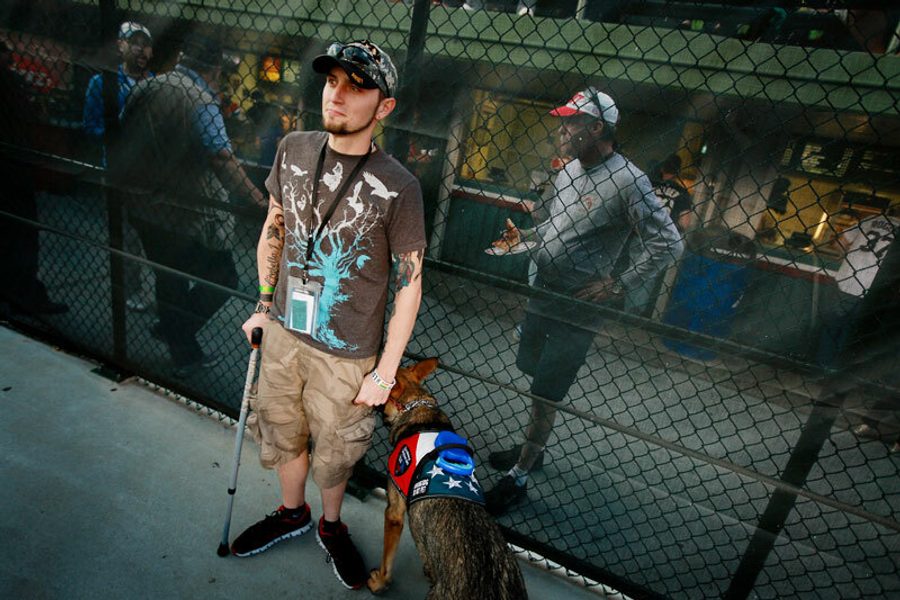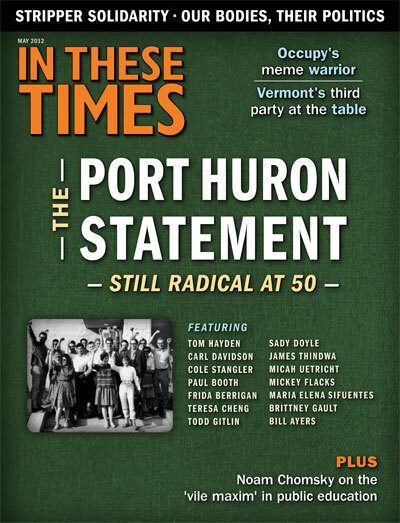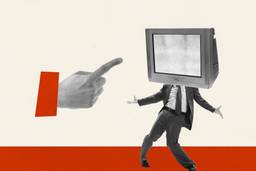Movement Building and ‘Summit Hopping’
Organizers debate the potential of mass demonstrations against NATO.
Rebecca Burns

While world leaders prepare the agenda for the NATO summit in Chicago this May, organizers are busy mobilizing a war-weary but politically re-energized U.S. public to greet them. Expectations are high for a show of popular strength against the military alliance.
But will the new politics inspired by the Occupy movement be dragged back into old routines by a familiar showdown between police and protesters? In These Times convened three peace and economic justice organizers for a discussion of the promise and pitfalls of targeting the summit: Patricia Hunt, an organizer with the Chicago-based Coalition Against NATO/G8; Judith LeBlanc, field director for Peace Action and co-coordinator of the Network for a NATO-Free Future counter-summit; and Staughton Lynd, peace activist, historian and member of Occupy Youngstown.
One criticism of mass demonstrations is that they fail to connect with, or even harm, local organizing efforts. Is this a danger of the upcoming protests in Chicago?
Staughton: In the interval between the 1999 World Trade Organization protests in Seattle and 9/11, many activists went into a pattern that might unkindly be described as summit-hopping. I had already experienced this pattern in the activity at the Democratic Party Conventions of 1964 and 1968, each of which was framed by the movement as a kind of apocalyptic final conflict with the powers of evil. And activists found it difficult afterwards to go back to the day-to-day patient, often frustrating organizing.
Pat: In Chicago, we see this as an opportunity to build a movement that doesn’t go from event to event to event. One of the things we want to do with our demonstration is to pull in the neighborhoods and the grassroots. The end of the summit is just the beginning – because we will have come to common ground locally as well as nationally and internationally.
Why is it important to protest NATO?
Staughton: I do think Chicago offers an enormous opportunity to focus on the war in Afghanistan. We should recognize that the folks who are going to be in Chicago are representatives of the governments that support the Afghanistan war, that have the theoretical power to call it off, and that they are one by one retreating.
Judith: In May, leaders of NATO countries will be discussing further expansion of NATO and the possibility of maintaining a NATO presence and commitment in Afghanistan after the 2014 troop withdrawal. At this moment, when we have public opinion moving in our direction on ending the war in Afghanistan, it’s crucial that we use this opportunity to educate people about what NATO represents and foster an alternative vision of what international collaboration means at a time of the decline of the U.S. empire.
Does President Obama’s announcement in March that the G8 would be held at Camp David, rather than Chicago, represent a victory?
Pat: The decision is a victory for the power of protest. But our message now is the same: No to NATO’s war agenda. No to G8’s poverty agenda.
With Chicago’s new restrictions on free speech and assembly, the right to public space is set to become a central issue during the summit. Is this potentially a distraction from other issues?
Judith: The struggle to influence public opinion is critical. We’re in a moment when there’s broad reflection on the costs of the wars and a budget that prioritizes funding the Pentagon over basic social services. In some ways, the civil liberties issue intersects with this. But it’s not the sole issue.
Staughton: Sequestering people in remote areas, or requiring permits before free speech takes place, has to be resisted.
Pat: We shouldn’t have to have a permit. The sidewalks are ours, but we went after permits for the demonstration we’re planning during the NATO summit because there are some people who will be deterred from coming out and speaking by the threat of arrest. We’re working toward a demonstration that is legal, permitted and family-friendly. But people are going to show up to protest NATO whether we plan something or not.
And some commentators have characterized the May protests as a moment when the Occupy movement must choose between nonviolent tactics and “violent tactics,” usually meaning property destruction. Is this a fair characterization?
Pat: The question of violence is a tactic used by the powers that be to try to intimidate people from coming to Chicago. For us to get involved in a conversation of violence vs. nonviolence feeds into building a wedge between our movement. What’s at issue is turning the spotlight to NATO and G8 and the type of violence that they do on a regular basis.
Staughton: It is not violence as such that worries me. But there’s an unresolved tension within the Occupy movement between the idea that everyone should be free to do his or her own thing, and the idea of consensus, understood not just as a way to run a meeting, but as a fundamental commitment to proceed together. The slogan “diversity of tactics” is an oversimplification. The fact is that the decision you make influences what’s going to happen to me.
Staughton, in an open letter to Occupiers, you urged those demonstrating this May to avoid a repeat of the 1968 Democratic National Convention. Why?
Staughton: At the time, the convention was considered a great victory by movement organizers. We had met the enemy and done fairly well, and the city of Chicago had disgraced itself through unnecessary brutality. But if you look at what the general public made of those events, they seem to have strengthened the eventual election of Richard Nixon. We shouldn’t confuse the immediate experience of those involved in the protest with how the activity appears nationwide.
So should demonstrators be concerned about the effect that these protests have on public opinion as it affects the 2012 elections?
Staughton: The best way we can influence the elections and President Obama is by nurturing an independent movement. Whatever decisions individuals make about electoral politics, this needs to be the principle.
Judith: It is important at moments like this to step back and realize that there hasn’t been any progressive change in U.S. history without such a movement.
How do you respond to the criticism that protesting these summits is reactive?
Judith: The beauty of the situation in Chicago is that it’s not simply protests. There will also be a counter-summit to foster creative thinking about how we can bring an end to militarism as the guiding principle for international relations. And there are creative actions. The Iraq Veterans Against the War are going to march to the NATO summit and turn their medals in. It’s going to be a moment that uplifts the theme of reconciliation.
Straughton: You can say that this action is reactive in that the time and place were determined by NATO. But we should use this momentary stage to exemplify the kind of world we believe in.
Pat: We’ve been given a gift to take this summit and educate people about what NATO is, what G8 is. If you’re not educating while you’re organizing, you’re doing something wrong.
Rebecca Burns is an In These Times contributing editor and award-winning investigative reporter. Her work has appeared in Bloomberg, the Chicago Reader, ProPublica, The Intercept, and USA Today. Follow her on Twitter @rejburns.









